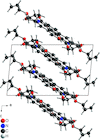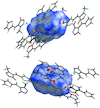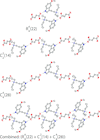issue contents
April 2021 issue

Cover illustration: The crystallization of most pigments is a difficult job as these compounds are rather insoluble. In an effort by Tapmeyer et al. to crystallize the sodium salt of Pigment Red 52 from dimethylsulfoxide, single crystals of the DMSO solvate hydrate were obtained. In this first crystal structure for Pigment Red 52, the SO3- group is deprotonated with the COOH group protonated and, in contrast to related structures, coplanar with the naphthyl ring. See: Tapmeyer, Eisenbeil, Bolte & Bolte [Acta Cryst. (2021). E77, 402-405].
research communications
Download citation


Download citation


A cluster containing copper(I), L-cysteine and chloride ions was synthesized and characterized by X-ray diffraction and FTIR spectroscopy.
CCDC reference: 2064015
Download citation


Download citation


The crystal structure of the title compound, C17H19NO4, consists of nearly planar molecules that are linked by intermolecular C—H⋯O hydrogen bonding into chains along the b-axis direction.
CCDC reference: 2064943
Download citation


Download citation


Reduced 3,4′-bipyrazole-2-carbothioamides are formed in cycloaddition reactions between chalcones and thiosemicarbazide, and these can undergo further cycloaddition reactions to form oxothaazole of thiazole substituents. Structure analysis establishes the regiochemistry of the cycloaddition reactions and shows the very simple patterns of supramolecular assembly in these compounds.
Download citation


Download citation


Crystal structures of three substituted N-tosylpyrrole compounds are reported; these compounds show a variety of `weak' intermolecular interactions owing to different substitution patterns and supramolecular arrangements. The benefits of collecting crystal structure data to extreme resolution (0.5 Å) are discussed.
Download citation


Download citation


In the crystal, the title molecules are linked by intermolecular C—H⋯N, C—H⋯Cl, C—H⋯π contacts and π–π stacking interactions. A Hirshfeld surface analysis was undertaken to quantify the intermolecular interactions.
CCDC reference: 2067449
Download citation


Download citation


The asymmetric units of compounds I and II both consist of two independent molecules. In the crystal of I, molecules are linked through N—H⋯O hydrogen bonds, forming inversion dimers with ![[R_{2}^{2}]](/e/issues/2021/04/00/yz2005/teximages/yz2005fi1.svg) (8) ring motifs and with their molecular planes parallel to (020). C—H⋯O interactions connect the dimers, forming a three-dimensional network. In the crystal of II, molecules are linked by C—H⋯N, C—H⋯O and C—H⋯π interactions, resulting in a three-dimensional network.
(8) ring motifs and with their molecular planes parallel to (020). C—H⋯O interactions connect the dimers, forming a three-dimensional network. In the crystal of II, molecules are linked by C—H⋯N, C—H⋯O and C—H⋯π interactions, resulting in a three-dimensional network.
Download citation


Download citation


The relative conformations about the three chiral carbon atoms are established. The two fused five-membered rings and their N-bound aromatic substituents form a pincer-like motif. In the crystal, a combination of C—H⋯O and C—H⋯N hydrogen bonds and C—H⋯π(ring) interactions leads to the formation of layers parallel to the bc plane with the diphenylpyrrole groups protruding from both sides of the layers.
CCDC reference: 2067379
Download citation


Download citation


A sterically congested piperazine derivative, tert-butyl 4-[4-(4-fluorophenyl)-2-methylbut-3-yn-2-yl]piperazine-1-carboxylate, was prepared using a modified Bruylants approach. Its novel chemistry with a synthetically useful second nitrogen atom on the N-tert-butyl piperazine substructure generates a pharmacologically useful core.
CCDC reference: 2067318
Download citation


Download citation


In the crystal structure, molecules are linked by N—H⋯O, C—H⋯O and C—H⋯N hydrogen bonds, forming molecular layers parallel to the bc plane, which interact by the van der Waals forces between them.
CCDC reference: 2068003
Download citation


Download citation


The title compounds, 8-{1-[3-(cyclopent-1-en-1-yl)benzyl]piperidin-4-yl}-2-methoxyquinoline and 8-{4-[3-(cyclopent-1-en-1-yl)benzyl]piperazin-1-yl}-2-methoxyquinoline differ only in the nature of the central six-membered ring: piperidine in the first and piperazine in the second. They are isoelectronic (CH cf. N) and isotypic. The major contribution to the intermolecular interactions in the crystals is from dispersion forces (Edis), reflecting the absence of classical hydrogen bonds.
Download citation


Download citation


The title compound, C9H7NO2S, crystallizes with two independent molecules (A and B) in the asymmetric unit with Z = 4.In the molecular skeleton of title compound, the angle between mean planes of the two molecules A and B is 4.09 (1)°. The two molecules A and B are involved in intermolecular C—H⋯O and C—H⋯N hydrogen bonds.
CCDC reference: 2069004
Download citation


Download citation


The structure of Cp′3U(BH4), (C5H4SiMe3)3U(BH4), at 112 K has triclinic (P![[\overline{1}]](/e/issues/2021/04/00/zl5005/teximages/zl5005fi1.svg) ) symmetry. It is of interest with respect to borohydride coordination modes.
) symmetry. It is of interest with respect to borohydride coordination modes.
CCDC reference: 2067867
Download citation


Download citation


The crystal structure of 4-chloro-2-methyl-6-oxo-3,6-dideuteropyrimidin-1-ium chloride exhibits unusual angles about an sp2 C atom, which are confirmed by theoretical calculations.
CCDC reference: 2069792
Download citation


Download citation


The isoxazolyl-benzimidazole moiety is not planar. In the crystal, N—H⋯N hydrogen bonds between neighboring benzimidazole rings form chains along the a-axis direction.
CCDC reference: 2048487
Download citation


Download citation


The crystal structure of a DMSO monosolvate monohydrate of a previously unknown monosodium salt of the industrial intermediate Pigment Red 52 (P.R.52) with the formula Na+[C18H12ClN2O6S]−·H2O·C2H6OS. The compound was obtained by in-house synthesis. The crystals have triclinic symmetry at 173 K. The crystal structure is built up by Na—O chains, which arrange the anions in polar/non-polar double layers.
CCDC reference: 2068733
Download citation


Download citation


The quaternary A2W3SeO12 (A = NH4, Cs, Rb, K or Tl) selenites have been prepared in the form of single crystals by hydrothermal and novel solid-state reactions. They were characterized by X-ray diffraction, thermal and spectroscopic studies. All of them have a hexagonal tungsten oxide (HTO) related [W3SeO12]2− anionic framework with pyramidally coordinated Se4+ ions.
Download citation


Download citation


In the title complex, [Cu(2-nitrobenzoate)2(tmeda)], the central metal atom has distorted square-planar geometry with one oxygen atom each from two 2-nitrobenzoate ligands and two TMEDA ligand nitrogen atoms.
CCDC reference: 1910225
Download citation


Download citation


The synthesis and solid-state structure of the fumarate salt of the synthetic psychedelic 5-methoxy-N,N-diallyltryptamine (5-MeO-DALT) is reported.
CCDC reference: 2070873
Download citation


Download citation


In the crystal of the title molecular salt, ion pairs are linked by C—H⋯Br and N—H⋯Br hydrogen bonds, which are connected into helical chains extending along the c-axis direction by weak, electrostatic S⋯Br− interactions.
CCDC reference: 2071135
Download citation


Download citation


In the title molecular salt, (C6H16N2)[CoCl4], the complete dication is generated by crystallographic inversion symmetry and the piperazine ring adopts a chair conformation with the pendant methyl groups in equatorial orientations. The complete dianion is generated by crystallographic twofold symmetry. In the crystal, the (C6H16N2)2+ and [CoCl4]2− ions are linked by N—H⋯Cl and C—H⋯Cl hydrogen bonds, thereby forming a two-dimensional supramolecular network.
CCDC reference: 1831453
Download citation


Download citation


In the crystal structure of the title compound the CoII cations are octahedrally coordinated by two terminal N-bonded thiocyanate anions and four 3-(aminomethyl)pyridine coligands, of which two are coordinated through the pyridine N atom and two through the amino N atom. The cations are linked by the coligands into layers, that are further connected into a three-dimensional network by intermolecular N—H⋯S hydrogen bonding.
CCDC reference: 2072509
Download citation


Download citation


The single-crystal structures of several maleate salt of bedaquiline, a drug used for the treatment of drug-resistant tuberculosis (TB), are described.
Download citation


Download citation


The structure, coordination geometry and extended hydrogen-bonded network of tris(ethane-1,2-diamine-κ2N,N′)cobalt(III) bis(iodide) triiodide is discussed.
CCDC reference: 2070495
addenda and errata
Download citation


Download citation


Corrigendum to Acta Cryst. (2007), E63, m2536.
CCDC reference: 2066475


 journal menu
journal menu










































